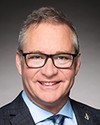Thank you for your question, Mr. Chair.
As you mentioned, I haven't been at the head of the National Gallery of Canada for very long. That means that I cannot unfortunately talk about the past. On the other hand, I can talk about where we stand today and where we're headed.
The current transformation of museum institutions is not limited to the National Gallery of Canada. It's the whole milieu, around the world, which has been striving to better understand and rectify any historical preconceptions and prejudices. My view is that it's very important for any such adjustments to be effected in a positive and constructive manner.
Acknowledging the diversity of Canadians and Canadian artists is extremely important, but it needs to be done by accrual to, rather than subtraction from, what the gallery has been producing and exhibiting. The best way to do this is by making sure that decisions are made with the right people around the table and with solid representation from this diversity, both within and outside our institutions, and on our advisory committees. That's how we work in putting together our current teams, and in all the considerations that come into play with respect to acquiring works of art, programming exhibitions, and conducting community and educational projects.
The works of art should speak to us, not the institution. I believe this to be a very important concept. The National Gallery of Canada does not have an ideology. No ideology has ever been forced upon it, either internally or externally, whether politically or financially. I believe it's our duty at the gallery to breathe life into the works, and to explain them and contextualize them now and in the future.




